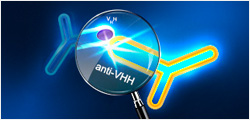| Species |
Human |
| Protein Construction |
NGFR (Lys29-Asn250)
Accession # P08138 |
|
| Purity |
> 95% as analyzed by SDS-PAGE |
| Endotoxin Level |
< 0.2 EU/μg of protein by gel clotting method |
| Biological Activity |
ED50 < 0.4 μg /ml, measured in a neutrolization assay using TF-1 cells in the presence of 10.0 ng/ml human b-NGF. |
| Expression System |
HEK 293 |
| Apparent Molecular Weight |
32~60 kDa, on SDS-PAGE under reducing conditions. |
| Formulation |
Lyophilized after extensive dialysis against PBS. |
| Reconstitution |
It is recommended that this vial be briefly centrifuged prior to opening to bring the contents to the bottom. Reconstitute the lyophilized powder in ddH₂O or PBS up to 100 μg/ml. |
| Storage & Stability |
Upon receiving, this product remains stable for up to 6 months at lower than -70°C. Upon reconstitution, the product should be stable for up to 1 week at 4°C or up to 3 months at -20°C. For long term storage it is recommended that a carrier protein (example 0.1% BSA) be added. Avoid repeated freeze-thaw cycles. |
| Target Background |
NGF Receptor, also known as Gp80-LNGFR, p75 ICD, CD271 and TNFRSF16, is a type I transmembrane protein belonging to the TNF receptor family. It is expressed by both neuronal and non-neuronal cells. Signaling through NGF Receptor has been shown to regulate gene expression, cell migration and death. A truncated NGF Receptor containing only the extracellular domain has been detected in plasma, amniotic fluid and urine, and acts as a potent NGF antagonist. |
| Synonyms |
Gp80-LNGFR; p75 ICD; CD271; TNFRSF16 |
For laboratory research use only. Direct ������human use, including taking orally and injection and clinical use are forbidden.

































